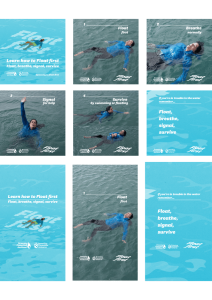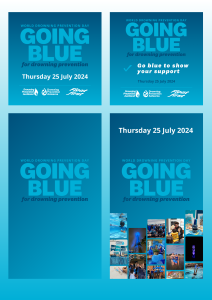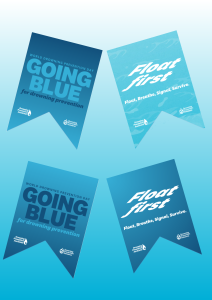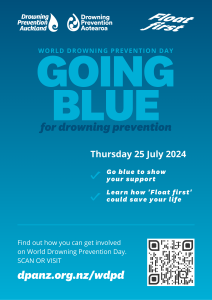Float first
What would you do if you fell into the water? How would you survive if you got caught in a strong current or rip? Knowing how to respond in the first two minutes can make the difference between life and death.
Panicking, or the effects of cold water shock, can lead to drowning or cardiac arrest. Even the strongest swimmers can be affected. Floating on your back gives you the best chance of survival if you’re in trouble in the water.
Learn how to Float first. Remember: Float, breathe, signal, survive.
How to Float first

Float first
- Lie back with your ears underwater, chin up
- Move your hands to help you float
- It’s okay if your feet sink
- Ignore your instinct to swim

Breathe normally
- Relax
- Slow your breathing to help you calm down
- Breathing will get easier

Signal for help
- Raise your arm
- Shout for help

Survive by swimming or floating
- Swim to safety if you can
- Float when it’s not safe to swim
- Hold onto anything that helps you float
- Keep clothes on to stay warmer
Float first Learning Resources

Poster
Help everyone remember how to Float first. English and te reo Māori.
DOWNLOAD

Colouring sheet
A colouring activity providing Float first fun for all ages.
DOWNLOAD

Digital content
Share these Float first resources on your social media channels.
DOWNLOAD

Activity cards
Short activity ideas to help your group learn about Float first.
DOWNLOAD
Lesson plans
Pre-school
Lesson plan and activities for children under the age of 5 years old.
DOWNLOAD
Junior Primary
Lesson plan and activities for junior primary school aged children.
DOWNLOAD
Senior Primary / Intermediate
Lesson plan and activities for students at senior primary or intermediate school.
DOWNLOAD
Youth and Adults
Lesson plan and activities for youth and adults of all ages.
DOWNLOAD
15 minute pool session
Lesson plan for running a pool-based session.
DOWNLOAD
Most adults can’t float as well as they think they can
Our recent study found that most adults think they can float, and two-thirds think they can float for more than five minutes. In-water testing revealed that only two percent could float more than five minutes, with one-third floating for less than 15 seconds (Stanley, 2021).
The dangers of cold water shock
When plunged into cold water our first instinct is to gasp for air with an uncontrollable ‘gasp reflex’. Taking on one large breath of water is enough to prove fatal. Our natural response is to swim hard and fight against the shock. This causes people to lose control of their movements and rapidly increases their heart rate, lowering the chances of survival. All this happens in under two minutes.
Can everyone float?
Whatever the age or aquatic experience, learning and thinking about floating as a first response is something we should all learn. The good news is that anyone can float*.
Floating is integral to all DPA educational programmes and is backed by international water competency research (Stallman et al., 2017) as one of the 15 water competencies needed for drowning prevention.
*During a trial of 85 people of different ages shapes, sizes, genders and swimming abilities, the University of Portsmouth research revealed that everyone truly can float, either on their own or with gentle sculling.
Water competencies for drowning prevention
Floating is just one of the fifteen research backed water competencies that integrate the skills, knowledge, attitudes and behaviours needed to prevent drowning. Check out the research behind Float first by reading about the floating water competency.
Learn to float (online or in person)
Teaching floating

Online Learning Module for teaching children to float
Learning to float

Online learning module for adults learning to float
Water Safety Programmes

Check out the programmes we offer to develop water competency within our communities
References
Barwood, M. J., Burrows, H., Cessford, J., & Goodall, S. (2016). “Float first and kick for your life”: Psychophysiological basis for safety behaviour on accidental short-term cold water immersion. Physiology & behavior, 154, 83-89.
RNLI. (2023, July 3). Float to Live. https://rnli.org/safety/float





















